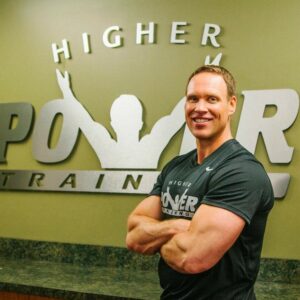In part one of this series on shoulder injury and prevention for swimmers, I covered why these athletes are at risk for developing shoulder pain and Upper Cross Syndrome (UPS) and why they are linked.
If your swimmers have UPS, there are exercises to help rehabilitate them. However, you must choose your exercises wisely. Consider how posture will affect the corrective and general exercises that you choose. Here are 9 tips to correct or prevent UPS while keeping posture in mind.
#1. Strengthen the Neck Flexors
What to do: Cervical flexion exercises.
Program for Posture: These neck flexors will also strengthen during any abdominal work (like crunches) performed from a supine position, expanding your repertoire of applicable exercises. However, as mentioned above, posture must be accommodated with UPS.
When performing crunches from the floor, a healthy thoracic spine will usually go through 0 to 30 degrees of flexion. However, when the athlete has a kyphotic spine, the thoracic flexion is even greater. This feeds their kyphosis, potentially exacerbating UPS.
The fix is to perform the crunch pattern on a curved surface like a BOSU ball. This allows the athlete to begin from a position of thoracic extension and flex the spine up to parallel with the floor. This prevents over-flexion of the thoracic spine and avoids flexion of the lumbar spine. Your spine is essentially in a neutral or close to neutral position. We call these bottom half crunches, where you crunch up to either neutral or slightly above neutral.
#2. Strengthen the Rhomboids and Middle Traps
What to do: Isolated work such as prone shoulder abduction (sometimes called Ts ) and integrated exercises like lat rows.
Program for Posture: One problem with rows is they tend to feed UPS if neutral thoracic spine position is not maintained. The worst offender is the seated pulley row. Some athletes will have a tendency to round the upper back (increase kyphosis) and protract the scapula during the start and finish positions. One possible correction for this is kneeling rows from a high pulley as this position favors thoracic extension and retraction. Suspension rows are another great option as the supine hanging position favors thoracic extension.
#3. Strengthen the Lower Traps
What to do: Isolation exercises such as prone Y’s and with integrated exercises such as vertical pulls.
Program for Posture: Lat pull downs may be better choices for vertical pulls than pull-ups, since with UPS shoulder flexion is limited. However, vertical pulls require at least 170 to 180 degrees of shoulder flexion. As a result, your athlete will need to lean back slightly in order to achieve the overhead position. Without the lean, the athlete will have to excessively arch the low back or rib cage in order to achieve the proper position.
#4. Strengthen the Serratus Anterior
What to do: Isolated exercises such as push-up with a plus, or Serratus Step-ups.
Program for Posture: Integrated work such as incline shoulder presses and straight overhead shoulder presses will strengthen the Serratus Anterior as well since it will rotate the scapula as the arms are pressed overhead. Use discretion with overhead work as the athlete that has UPS may only achieve the overhead position through compensation of lumbar hyperextension or excessive rib cage arch. If it is necessary to perform shoulder presses, opt for an incline press of around 70 degrees.
#5. Strengthen the Shoulder External Rotators
This is possible with exercises from a variety of positions of shoulder abduction to correct the internal rotation related to UPS. In addition, stronger external rotation will balance out the repetitive motion of internal rotation with most swimming strokes.
#6. Strengthen the Lats
This was addressed in #2 and #3. The lats will work with multi-joint motions that target the Rhomboids and Middle Traps (horizontal pulls) and Lower Traps (vertical pulls). Strengthening the lats will encourage more thoracic extension in the spine and will help to retract and depress the scapula. In addition, since the lats oppose the pecs, stronger lats will inhibit tightness in the pecs.
#7. Increase the Mobility of the Thoracic Spine
Perform exercises that work on both extension, and rotation of the thoracic spine.
#8. Stretch the surrounding areas
Stretch the Pectoralis Major, Pectoralis Minor, the shoulder internal rotators, and the neck muscle group: Suboccipitals, Scalenes, Levator Scapula, Sternocleidomastoid, and Upper Traps


#9. Consider how posture will affect other exercise choices
Posture for other exercises must be considered as well. Posterior chain exercises such as deadlifts, Russian deadlifts, and hip extension exercises on the glute ham or 45-degree hip extension tend to pull the upper crossed individual into even more kyphosis. When training the posterior chain, perform hip extension exercises such as the reverse hyper, or perform hip extension exercises with an overhead reach. The overhead reach will put the thoracic spine into more extension. Any exercise where you rack a bar on your back (barbell squats, barbell split squats, barbell lunges, barbell good mornings) can push the athlete into further kyphosis. Loading this position may increase chances for a disc injury. Instead, opt for other exercises such as front squats, step-ups or lunges.
It is possible for your athletes to perform all the right stretches and strengthening exercises, but posture must also be programmed mentally. Your athletes must be reminded to focus on maintaining good posture in their exercises and daily life. While it won’t happen overnight, you can correct and prevent shoulder pain with these exercises, resulting in less pain over time.
Featured Equipment







